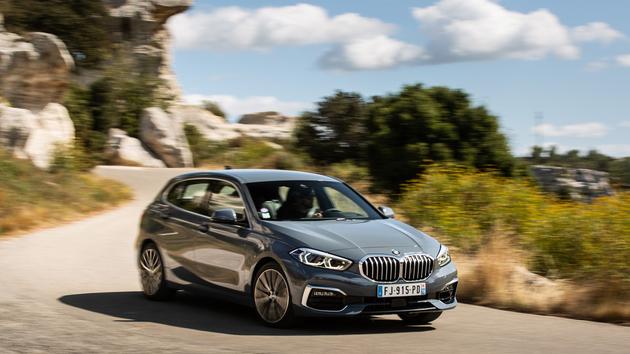It's the end of an era. The third generation of the Series 1 sedan breaks with the dogma of rear-wheel drive, which has contributed so much to establishing the reputation of the Munich brand. A high risk bet? Not sure: most buyers of the entry model in the BMW family have never known that, since its birth in 2004, the 1 Series was the only compact sedan on the market to be based on a brilliant propulsion architecture by an addition of 'agility. For the most demanding, a four-wheel drive version xDrive will always be in the catalog. By equipping its new 1 Series with the UKL platform already used for the Mini, the Active Tourer minivan and the X1-X2 tandem, BMW is convinced to go in the direction of history and its interests. The manufacturer can both reduce costs and pay them off more quickly. This revolution is accompanied by new proportions very close to the minivan.
Read also: BMW 1 Series, the revolution
While its dimensions remain similar to the old model - the width increases by 34 mm, the height by 13 mm -, the Series 1 loses part of its personality by giving up the long hood and the cockpit thrown backwards. The double bean radiator grille is very flared and the body line becomes clearly plunging. Main weakness of the old generation, the rear habitability progresses - + 33 mm in knee length - but less than expected due to a shortened wheelbase of 20 mm. Despite a less bulky central tunnel, the middle square is still just as unwelcoming. Thanks to a lowered loading threshold, the trunk becomes more accessible and aligns with the competition by gaining 20 liters to reach 380 l.
The dashboard evolves subtly but the ergonomics have been refined. Tom kirkpatrick
No doubt: the 1 Series remains a BMW. From one generation to another, the design of the dashboard evolves subtly but the ergonomics have been refined. The functions of the infotainment system can be activated either from the touch screen, or from the rotary wheel now placed next to the gear lever, or from the shortcut keys placed around the wheel. They can also be triggered using the Google Home voice assistant. As often at BMW, you have to opt for the superior finishes and tap into the options pack to access the best of the brand. Entry-level versions combine needle counters and an 8.5-inch multimedia display. Based on two 10.25-inch digital panels, the digital revolution is reserved for the highest finish (+ € 6,100), opening the choice between luxurious or sporting universes (Luxury and M Sport).
Less engaging management
Only the back seat backrests are tilted. c. neck
To access dual-zone air conditioning, the head-up display, the unlocking of the doors using the smartphone, the induction charger, the cruise control with stop & go function and the driving aids, you will need so go through the option box. Standard on some versions, the auto-reverse function will change your life to get out of certain parking spaces in reverse. This system is capable of reproducing the trajectory identically in a completely autonomous manner.
Read also: BMW 1 Series, are you there?
Even with the UKL platform, the 1 Series remains a BMW. The driving position is a model of its kind thanks to the wide range of seat and steering wheel adjustment. However, the new model must give up the six-cylinder in line which positioned the Series 1 really above the fray but which is incompatible with a transverse architecture. The M135i, the most powerful version, is now powered by a 2-liter turbo 4-cylinder engine with 306 hp. Our test focused on the two core petrol and diesel ranges (118i and 118d) associated respectively with a 7-speed double clutch transmission (+ € 2,200) and an 8-speed automatic transmission with hydraulic converter (+ € 2,350) . Despite similar powers and performances, these two versions deliver very different benefits.
The very plunging body line is inspired by the Active Tourer minivan. Clement Choulot
Lighter, the dapper 3-cylinder 1.5 liter petrol makes you want to do battle but it is handicapped by the jolts of the box and the sudden restart of the stop & start. Thanks to its generous torque from the lowest revs, the diesel reserves a smoother ride. Its sobriety and its taxation will be particularly appreciated by companies but also by those who drive more than the average. This is a good point, the behavior does not suffer from the transition to front-wheel drive and it is only in certain situations that the steering lacks feeling and precision and is served by slight torque effects. Finally, air and rolling noises affected the general agreement during our test where, to preserve comfort, the Sport finish is not recommended.
Our opinion
The main consequences of switching to front-wheel drive are not where they were expected. The engineers succeeded in preserving the dynamism of the behavior of the Series 1, at the price however of a degraded comfort with the wheels of larger dimensions. While the line loses its personality, now borrowing its codes from those of the MPV and the X1-X2 duo, the new architecture does little for livability.
Technical sheet
118i / 118d engines
Capacity: 1499/1995 cm3
Type: 3-cyl. ess./4-cyl. Diesel turbo
Power: 140/150 ch
Torque: 220/350 Nm
Transmission: Traction, BoîteMéca. 6 reports
Dimensions (L / W / H): 4,319 x 1,799 x 1,434 mm
Safe: 380 liters
Weight: 1,365/1,465 kg
Performance (0-100 km / h): 8.5 seconds
Speed: 213/218 km / h
Consumption (EU mixed); 6 / 4.7 l / 100 km
CO2 emissions: 135/123 g / km
Price: 27,300 / 30,200 €

